Organic Farm & Mill and Salumi Tasting # 1
Today we visited an Organic Farm and Mill La Terra E Il Cielo (the earth and the sky) that follows the lunar cycles for the planting of its crops. The mill is from the 17th century and is water powered. They produce mostly organic flour and grains for pasta. They produce durum wheat, spelt, and barely (orzo). They also produce a corn meal based on an old variety of corn called Mais Ottofile, because it has eight (otto) rows. This corn is lower yielding variety because it only has eight rows. The mill and farms are a co-operative of 100 small farmers. They practice profit sharing. The company started in 1980 as an organic farm that only produced enough products to supply the families involved at the time. The group is now quit large shipping its products to many different countries. Their pasta’s have won many awards in Italy for being the best organic, whole grain pasta available. They stressed to us the same thing that Peppe Zullo did – Terra to Tavola!
Salami – Tasting-Nicola Gattanella
Salami derived from Latin Salumen – to preserve with salt.
#1 Start with a great product – 3 primary factors influence this:
· Wild or semi wild – animal is of utmost importance
· The Feeding is noble –no by products, little grain, Forago Fresco-wild foraged food is best
· Choice of breed- Very high quality Italian breeds include:
o Casertana – Black Pig –from the same area in the south that Mozzarella comes from
o Mora Romangnola – typical of Marche
o Cinta Senese- originally from Tuscany, but now found in other parts of Italy. Black with a white band around the neck. Considered to be one the best breeds in Italy.
The day before slaughter reduce the feed to the animals and move to the slaughter location so they are not stressed before the slaughter. If the animals are stressed before the slaughter the meat will have a higher content of lactic acid which will have an adverse effect on the taste and texture of the meat. Important that they do not see other slaughtered animals or it causes them stress. We tasted several types of Salumi –some industrial and some artisanal so we could compare.
· Tasting is a lot like tasting wine, start with a visual first, look at the outside and determine if it has mold. There should be mold, should be even coverage and should be white. A little green mold is ok, black is not. White is often faked with rice flour in industrial processing.
· Casing – should be natural, not synthetic, the natural casing lets more flavor develop in the salami
· Color- once sliced – should be even from the center out. Not too pink, if it is too pink too much Nitrite was used
· Skin – should peel off easily, not be sticky
· Smell – should smell of the meat first, spices and aging second, and some acidity
· Mouth feel- the product should dissolve in the mouth. Should not be tough or chewy (may be a sign of lactic acid).
· Taste-should be of meat first, then the aging and seasoning. Salt or spices should not dominate
Types tasted:
· Ciauscolo – Typical of the Marche 50-60% Meat and 50-40% Fat – Semi soft because of the high Fat content. Seasoned with Salt, Pepper and Garlic. Aged about 20-60 days. Made will Belly, shoulder, and other various cuts. They say people in the area like to spread it on bread. Tasted two industrial – neither great, but one was more flavorful and pleasant than the other.
· Salame Lardellata – from Fabriano – From the loin and fat back, Seasoned with Salt and Pepper, the lean meat is very lean interspersed with hand cut fat. Aged 50-150 days. These were industrial and were not distinguished.
· Salame di Fabriano- typically served around Easter. Lean meat only taken from the thigh – fat only from the back (best). Meat is ground and mixed with little fat, is fairly lean. Fat is hand cubed and mixed in. Tiny bit of smoke, because traditionally they hung in the kitchen and picked up a little smoke from the oven and fireplace. The diced fat is salted before mixing in so it cures a little and has flavoring on its own. Artisanal.
· Coppa di Testa – head cheese – Head, Nose, Ears, Tongue, Cheek, bones and other scraps – Salt, Pepper-can have things like green olives, orange peel, lemon peel, cinnamon, garlic paste, pistachios, almonds etc. Industrial, not distinguished.
· Salsicce – Fresh Sausage – we tasted raw and cooked. Good quality fresh sausage.
· Mortadella – True Mortadella de Bologna does not contain pistachios. Meat is from the leg, tripe, cheek (guanciale), and throat (gola). Spices – Salt, White Pepper, Nutmeg, Coriander, Garlic and in some versions Pistachios. It is an emulsion forcemeat using ice to make a very fine and smooth forcemeat. Back fat(lardo) is cubed, blanched and folded in. Pasquini is a high quality producer in Bologna. Very delicate, delicious
· Cervo Salame – Deer Salame – from Fruili region in the northeast. Deer 70%, Pork Fat Back 30% -salt, pepper, wine, garlic, and “mountain aromas”. It is lightly smoked, and has a “wild” taste. Actually very good, not too strong. It was covered in Farina di Mais (corn meal), and had a semi soft texture.
· N’ Duja – Calabria- looked like a bread loaf, but dark red, semi soft, like a big semi soft pepperoni, very spicy with hot pepper, left a lingering burning sensation, but good if you like spicy! He suggested that it is wonderful with pasta, and I concur that it would be tasty.
Subscribe to:
Post Comments (Atom)











































































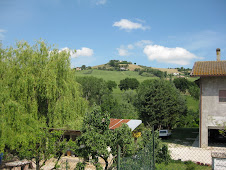

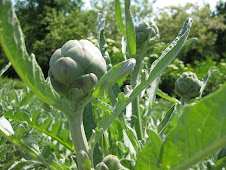


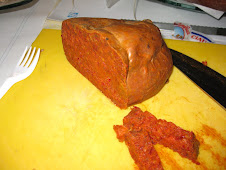
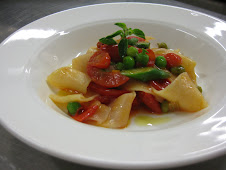
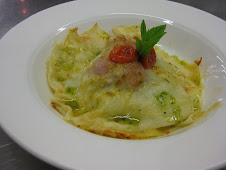
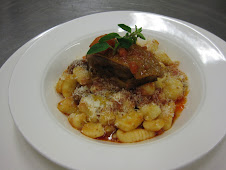








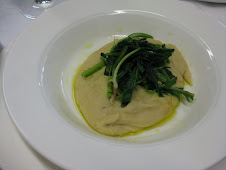

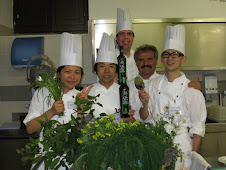
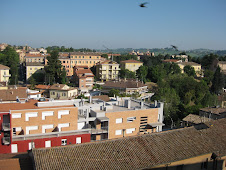


3 comments:
Are you going to make any charcutrie?
We art tasting plently and disucssing the processes and today we did butchery all day, but I don't think we will make any dry cured, unless I stay for a stage with the butcher.
Hey- that salami we made with the super high fat content is like the stuff we tasted the other day- good for spreading it on bread etc. Maybe you should take it down? Keep an eye on it.
I just put in the upstairs walk-in. They looked great. We will sample them when you'll come back. It is great what you do there.
Post a Comment